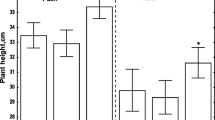Summary
1. A roughly quantitative technique for studying uptake and translocation of the antibiotic griseofulvin by wheat plants has been devised. Wheat plants were grown in nutrient solutions containing griseofulvin and translocation measured by bioassay of the griseofulvin appearing in the guttation drops induced by transfer to a humid atmosphere.
2. Griseofulvin was phytotoxic at concentrations of 5 µg/ml and above, the first symptoms observed being stunting and swelling of the roots.
3. The concentration of griseofulvin in the guttation drops was directly related to the concentration in the nutrient solution; there was evidence of griseofulvin accumulation in the leaves, the concentration in the guttation drops being frequently higher than that in the nutrient solution.
4. Atmospheric conditions favouring transpiration increased uptake and translocation of griseofulvin.
5. Uptake and translocation of griseofulvin was inhibited by inclusion of respiratory enzyme inhibitors in the nutrient solution.
Similar content being viewed by others
References
Arisz, W. H., Transport of organic compounds. Ann. Rev. Plant Physiol.,3, 109–130 (1952).
Brian, P. W., Studies on the biological activity of griseofulvin. Ann. Botany N.S.13, 59–77 (1949).
Brian, P. W., Antibiotics as systemic fungicides and bactericides. Ann. Applied Biol.39, 434–438 (1952).
Brian, P. W., Curtis, P. J. and Hemming, H. G., A substance causing abnormal development of fungal hyphae produced byPenicillium janczewskii Zal. I. Biological assay, production and isolation of ‘curling factor’. Trans. Brit. Mycol. Soc.29, 173–187 (1946).
Brian, P. W., Wright, J. M., Stubbs, J. and Way, A. M., Uptake of antibiotic metabolites of soil microorganisms by plants. Nature167, 347 (1951).
Hackett, D. P. and Thimann, K. V., The action of inhibitors on water uptake by potato tissue. Plant Physiol.25, 648–652 (1950).
Hoagland, D. R. and Snyder, W. C., Nutrition of strawberry plants under controlled conditions. Proc. Am. Soc. Hort. Sci.30, 288 (1933).
Machlis, L., The influence of some respiratory inhibitors and intermediates on respiration and salt accumulation by excised barley roots. Am. J. Botany31, 183–192 (1944).
Milthorpe, J. and Robertson, R. N., Studies in the metabolism of plant cells. VI. Salt respiration and accumulation in barley roots. Australian J. Exp. Biol. Med. Sci.26, 189–197 (1948).
Mitchell, J. W. and Marth, P. C., Growth regulating substances in horticulture. Ann. Rev. Plant Physiol.1, 125–340 (1950).
Nance, J. F., Inhibiting nitrate assimilation in excised wheat roots by various respiratory poisons. Plant Physiol.25, 722–735 (1950).
Robertson, R. N., Wilkins, M. J. and Weeks, D. C., Studies in the metabolism of plant cells. IX. The effects of 2,4-dinitrophenol on salt accumulation and salt respiration. Australian J. Sci. Research B4, 248–264 (1951).
Stubbs, J., The evaluation of systemic fungicides by means ofAlternaria solani on tomato. Ann. Applied Biol.39, 439–441 (1952).
Wright, J. M., Phytotoxic effects of some antibiotics. Ann. Botany N.S.15, 493–499 (1951).
Author information
Authors and Affiliations
Rights and permissions
About this article
Cite this article
Stokes, A. Uptake and translocation of griseofulvin by wheat seedlings. Plant Soil 5, 132–142 (1954). https://doi.org/10.1007/BF01343846
Received:
Issue Date:
DOI: https://doi.org/10.1007/BF01343846




